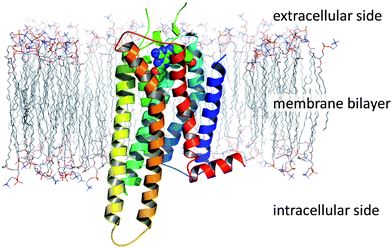Introduction of GPR25
GPR25 is encoded by the GPR25 gene. It belongs to the G-protein-coupled receptor (GPCR) family which offers numerous therapeutic targets for a broad spectrum of diseases. GPR25 is one of a class A orphan GPCRs which has a similar structure to other identified GPCRs and whose endogenous ligand has not yet been identified. Meanwhile, its amino acid sequence reveals that GPR25 shares about 29%-34% identity with vertebrate Apelin receptor (APLNR), which plays an important role in vascular development.
| Basic Information of GPR25 | |
| Protein Name | Probable G-protein coupled receptor 25 |
| Gene Name | GPR25 |
| Aliases | NA |
| Organism | Homo sapiens (Human) |
| UniProt ID | O00155 |
| Transmembrane Times | 7 |
| Length (aa) | 361 |
| Sequence | MAPTEPWSPSPGSAPWDYSGLDGLEELELCPAGDLPYGYVYIPALYLAAFAVGLLGNAFVVWLLAGRRGPRRLVDTFVLHLAAADLGFVLTLPLWAAAAALGGRWPFGDGLCKLSSFALAGTRCAGALLLAGMSVDRYLAVVKLLEARPLRTPRCALASCCGVWAVALLAGLPSLVYRGLQPLPGGQDSQCGEEPSHAFQGLSLLLLLLTFVLPLVVTLFCYCRISRRLRRPPHVGRARRNSLRIIFAIESTFVGSWLPFSALRAVFHLARLGALPLPCPLLLALRWGLTIATCLAFVNSCANPLIYLLLDRSFRARALDGACGRTGRLARRISSASSLSRDDSSVFRCRAQAANTASASW |
Function of GPR25 Membrane Protein
GPR25 was cloned and mapped on human chromosome 1 in 1997 firstly. It expresses mainly in human T-cells and NK-cells based on a genome-wide association study. GPR25 shares about 29%-34% amino acid sequence identity with vertebrate Apelin receptor (APLNR), which is activated by its endogenous ligand, Apelin. So, some studies showed that GPR25 could be activated by Apelin, and its activation can decrease intracellular cAMP levels. The GPR25 signaling pathway is similar to APLNR signaling relatively. As suggested in previous studies, GPR25 and APLNR show some degree of internalization as many GPCRs in response to ligand stimulation. Meanwhile, APLNR is capable of forming heterodimers with other GPCRs, such as KOR to exert its biological functions, so GPR25 has the possibility to form hetero-dimerize with other GPCR(s) as APLNR. Although many questions regarding the physiological roles of GPR25 remain unidentified, some studies have set up a critical starting point to reveal the biological mechanism of GPR25 in disease processes.
 Fig.1 Structure of GPR25 membrane protein (Andrews, 2013).
Fig.1 Structure of GPR25 membrane protein (Andrews, 2013).
Application of GPR25 Membrane Protein in Literature
This article reports that the GPR25 signaling pathway may act in a way more or less similar to APLNR signaling because GPR25 can be activated by Apelin, which is the endogenous ligand of APLNR.
This article focuses on evaluating the biological function of orphan class-A G protein coupled receptors in the cAMP signaling pathway. It shows that the cAMP-dependent constitutive activity was observed in GPR25 transiently expressed CHO-K1 cells.
Authors in this group apply the PCR primers based on the primary sequence of the somatostatin receptors (SSTR) and somatostatin-like receptor gene SLC-1 to the isolate and amplify the gene of GPR25 firstly.
This article reveals that GPR25 may act in a way more or less similar to SMOC-1 to regulate the blood pressure because GPR25 and SMOC-1 locate in the linked regions in human chromosome 1.
This article evaluates GPCR proteins (GPR1, GPR64, GPRC5A, GPR171, GPR176, GPR32, GPR25, GPR124) and their signal transduction pathways, were found to be regulated by inflammatory cytokines, chemokines, and growth factors.
GPR25 Preparation Options
To obtain the soluble and functional target protein, the versatile Magic™ membrane protein production platform in Creative Biolabs enables many flexible options, from which you can always find a better match for your particular project. Aided by our versatile Magic™ anti-membrane protein antibody discovery platform, we also provide customized anti-GPR25 antibody development services.
As a forward-looking research institute as well as a leading customer service provider in the field of membrane protein, Creative Biolabs has won good reputation among our worldwide customers for successfully accomplishing numerous challenging projects including generation of many functional membrane proteins. Please feel free to contact us for more information.
Reference
All listed services and products are For Research Use Only. Do Not use in any diagnostic or therapeutic applications.